Actually played a severe game "Azur" requesting highly bargain between players against the beauty of appearance

With a simple rule of collecting colorful tiles and arranging them on their own board, even beginners can play casually, while deep board games that can enjoy advanced bargaining like reading shogi like opponent like shogi "Azur"is. "King of Portugal ·Manuel I of EnglandAs a tile craftworker who will serve the Evora Palace decorate the walls of the Evora Palace with colorful tiles ", there is also fun to watch as well as pleasure to play, so the Japanese version that appeared on February 28, 2018 I actually played it in the editorial department.
Azul
https://www.planbgames.com/en/home/30-azul.html
Azur - ANALOG GAME INDEX
http://hobbyjapan.games/azul/
Outer box of Azur is like this. It is designed to be covered with colorful tiles.

There was a rough game flow recorded on the back of the box.

In addition to the rule book, when opening the box, there were 9 disc-shaped workshop exhibition boards and 4 player boards.
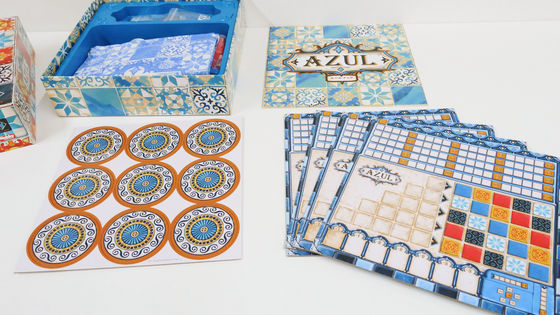
There was one blue cloth bag with the name of the game, the first player marker marked "1", the four black scoring markers, and the five color tiles.
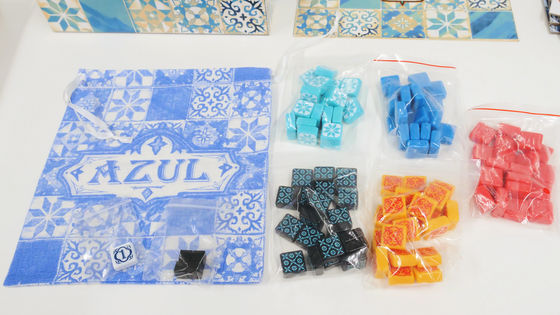
Five kinds of tiles look like this. Blue · Red is plain, yellow · black · light blue is patterned. Everything is shiny and vivid in eyes. There are 20 tiles for each color, totaling 100 sheets.
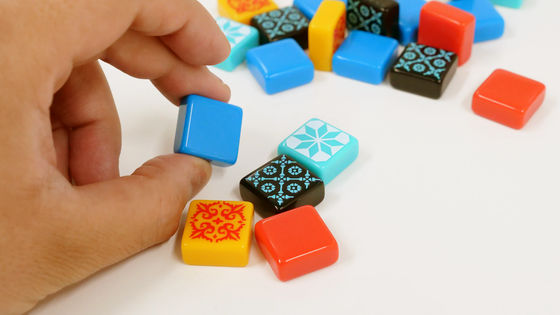
First of all, I tried playing "Azur" by two people. First put all the tiles in the cloth bag.
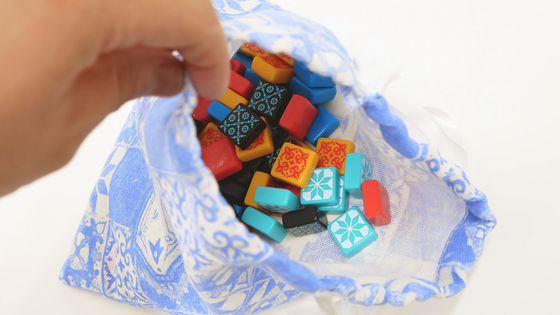
Place the studio presentation board in the center in the center. The number of workshop presentation boards varies according to the number of players, and for two players, five pieces will be placed.
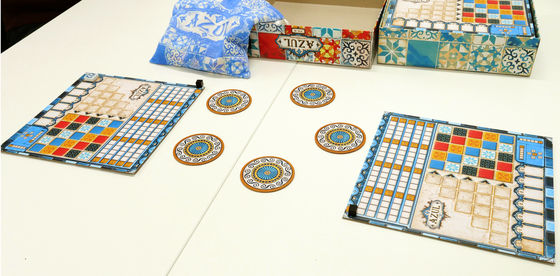
I will decide the first player. It was written in the rule book that "the player who recently visited Portugal is the first player," but since it turned out that neither had been to Portugal, I decided it by Janeken straightforwardly. The first player receives the "first player marker".
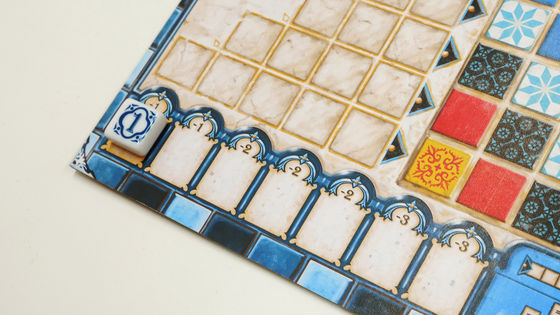
The first player takes out four randomly selected tiles from the bag and places each on the studio presentation board. Once the tiles are placed on all the studio presentation boards, it is ready. The game is roughly "getting the tiles in order" → "place the tiles on the walls" and this is repeated over and over and the player who earned the most points gets victory.
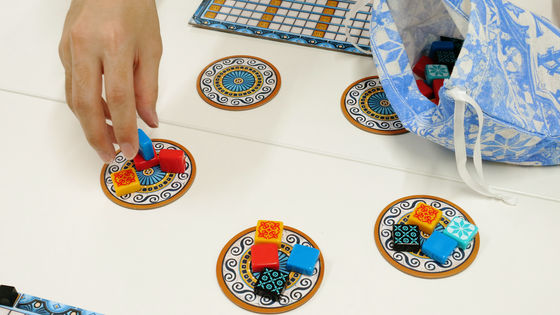
Firstly, from the first player, I get a tile from the studio presentation board. However, there is a rule that "you can get one tile at a time," "You have to take all the tiles of the color you choose". In the case of the image below, since I selected yellow, I got all 2 yellow.
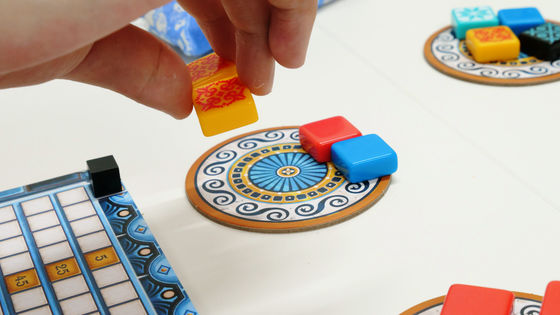
And the tiles left on the workshop presentation board are moved to the center. In this case, the first player also puts the first player marker in the center together. From the latter player, you can collect not only from the studio presentation board but also from this central player marker if it is the same color.
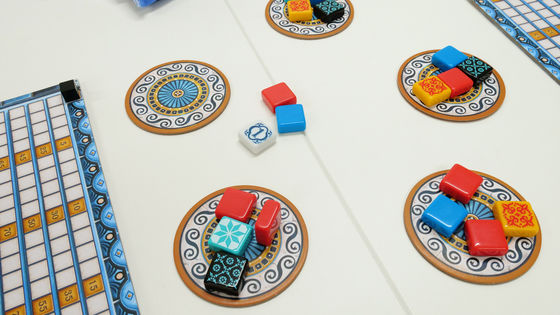
Place the studio presentation board and the tiles you get from the center in the "Design line" at the bottom left of the player board. The design line is a staircase pattern of 5 columns. There is a limitation that you can put tiles up to 1 stage at a time and even 1 tile can only place tiles of the same color. The colorful area to the right of the design line is a "wall of the palace" where the tiles are placed, and we will collect tiles to make this same design.
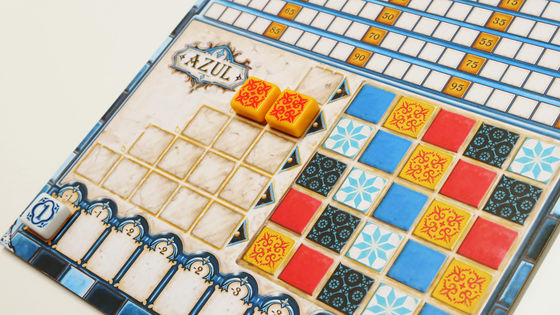
"One color at a time, pick all the colors you choose" "The rule that you can put tiles up to 1 stage at a time, do not put tiles of different colors on the same stage" rules will enhance the strategy of this game It is a point. For example, the following image shows that all the tiles on the studio presentation board are gone, and 6 yellow, 4 light blue and 3 red are left in the center.
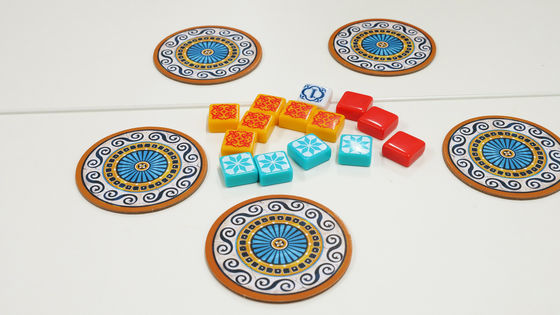
However, red, yellow and blue tiles are already placed in the 3rd, 4th, and 5th stage of the design line respectively. There is no place to place it because the red of the third row is filled, only yellow one in the fourth row can be placed. I had no choice but to get 4 pieces of light blue and place it on the 2nd row of the design line, but since it can only be put in 2 pieces on the 2nd step, it is left over.
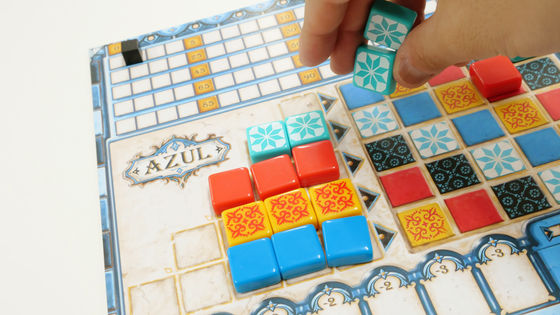
The two extra tiles will be placed on the floor line as shown below, saying, "I dropped tiles that I could not remove onto the floor." A minus is written above the floor line. Since the deduction is a negative total, it has been decided that 4 points will be deducted at this point as well.
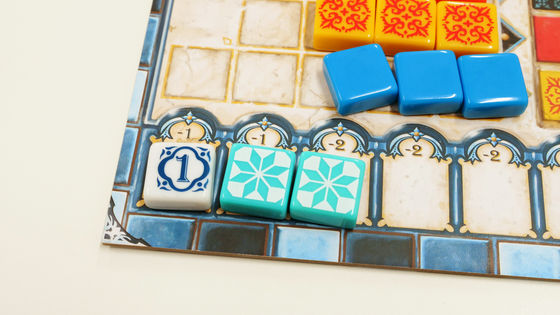
After that, after that, the other party brought three reds, so the remaining 6 yellow pieces came round here. One out of six can be placed in the fourth row of the design line, but there are no places to put any remaining 5 thoughts.
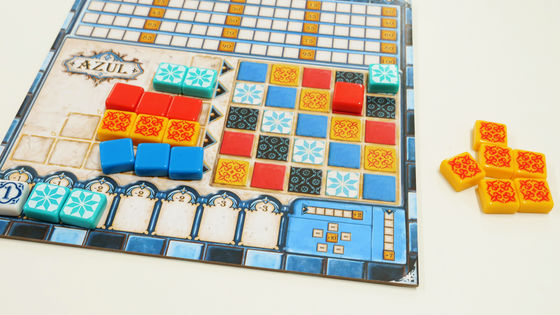
After all, the remaining five yellow tiles flow to the floor line. You can put up to 8 floor lines and put in the box lid for anything that could not be placed even. By filling up all the floor lines, 14 points of deduction have been confirmed. The point that it is important that the bargain of "to think about how you can interfere with your opponent if you take any tile" is behind a simple and easy-to-understand rule "get the necessary tiles" It can be said that it is the liver of the game "Azure".

Phase ends when all the tiles disappear from the battlefield. Everyone places the tiles on the wall.
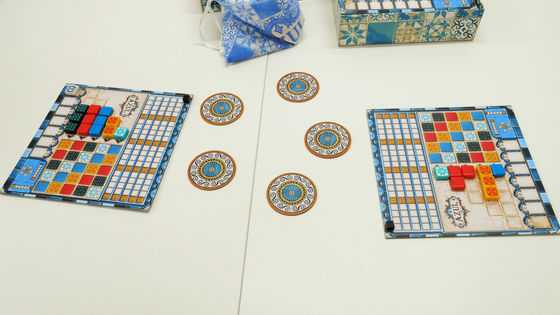
From the top of the design line, place the tiles at the right end of the filled row, in the same column & the same color location. For each tile you place one victory point.

However, if you place tiles horizontally and vertically adjacent to each other, the number of points you can receive increases. For example, in the image below, if you place a blue tile, two vertically will be lining up so you can get two points.
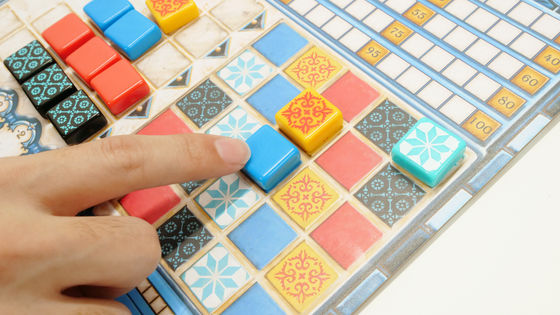
In addition, in the image below, you can get a total of 7 points because 5 vertical rows and 2 horizontal rows are lined up by placing black tiles in the second row. It is important not only to arrange in this way, but also to aim for a score combo by considering where in order to arrange.
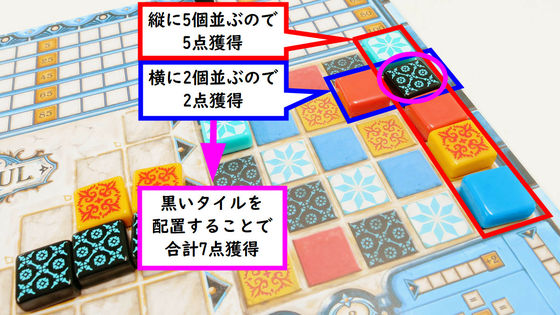
Furthermore, it is only the rightmost tile placed on the wall of the palace in the buried step, the rest temporarily put in the lid of the box. In addition, we leave stages that are not completely filled. In the case of the following images, the fourth row (red) and the fifth row (black) of the design line are not buried yet, so they will not be placed on the wall and will be carried over to the next round.
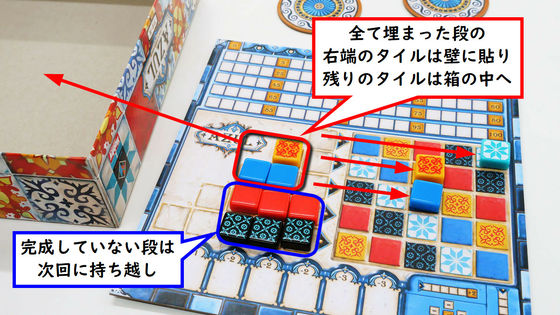
With the above flow, I will repeat "take tiles" → "score tiles side by side" → "arrange tiles on the studio presentation board". If there are no tiles in the bag, replenish the tiles temporarily placed in the lid of the box.

If someone arranges one or more tiles horizontally, the game will end in that round.

Since there are additional points depending on the arrangement of the tiles at the end, this is taken into consideration, and the player with the final high score will win.
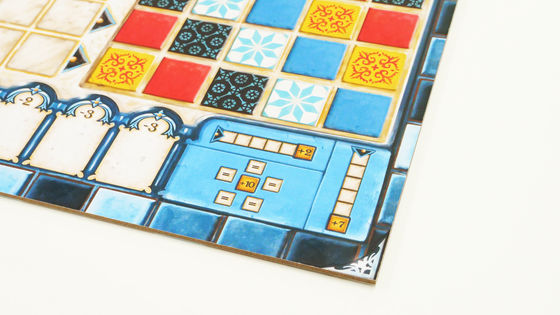
In addition, the player board is on the front and back, you can play with selection rules when turned inside out. In the selection rule, the walls of the palace are all gray and you can place the tiles in your favorite places, unless you place tiles of the same color in the same column / column.
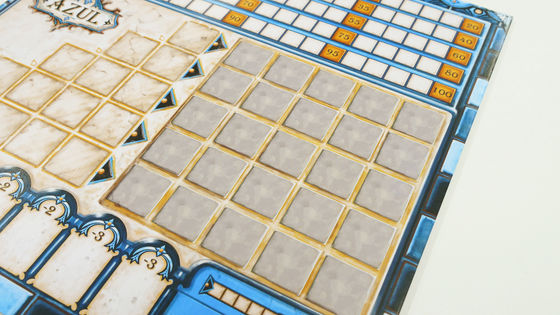
With conventional rules, it was possible to infer "how many tiles you want in the other party" by seeing the opponent's player board, but if you like selection rules It can be placed in places, so it is very difficult to guess.
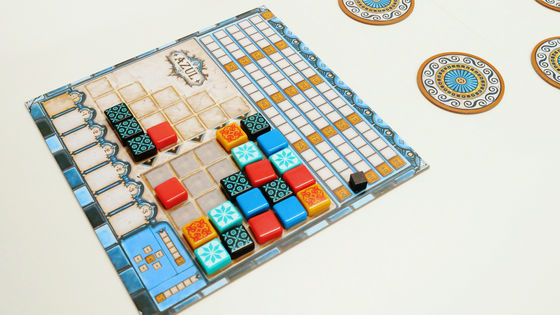
The following image was played with 4 players with normal rules. As the number of people increases, the number of tiles presenting board increases, and the number of tiles going to play increases. As tiles are easier to gather in the center, there are also many scenes where you choose to take tiles within a few to deduce a deduction before dying in the middle of the tile. Because all the placement of tiles other than myself is also visible, there are often situations where it is also required to read the "other's thinking" that can not be seen, so we enjoyed more complicated game characteristics than two players.
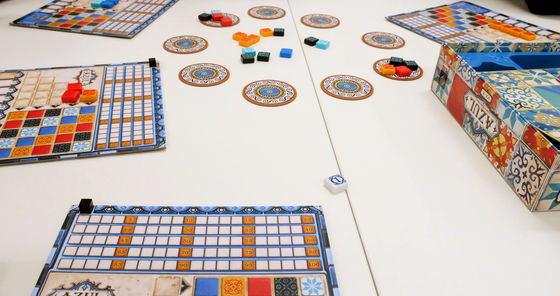
"Azur" is extremely simple as the rule itself, so even beginners in board games can understand and play immediately. From the editorial staff who played together with a colorful and elaborate design such as boxes, tiles, boards, "Even if I lose," Vertical rows were lined up "" Small accomplishment " There is also the opinion that it is fun to be able to get ", not only can you compete for victory or losing, but also you can enjoy by watching.
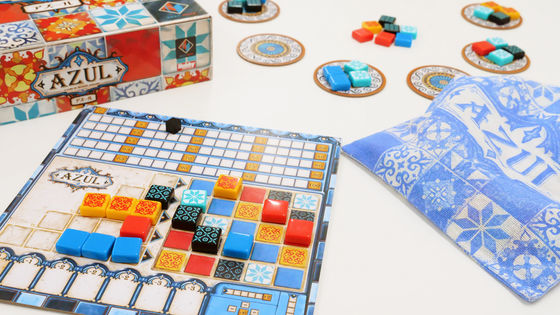
Also, contrary to the cleanliness of appearance and simple rules, "Where to handle unwanted tiles", "What kind of tiles are you currently wanting?", Ideas and troubles are properly prepared It has become very innermost.
"Azure" has no element of "information invisible to yourself" such as hands and hidden cards, all tile placement and designs are rounded out. Since there is almost no part affected by luck, after the middle stage I felt the game nature close to Shogi "Especially predicting the movement of the opponent and deciding my action." However, because everyone else thinks of it, it is easy for the tempo to get worse by all means, so it is good to set a time limit by making use of stopwatches and counter clocks.
The price of Japanese version of Azur is 6048 yen including tax, which is also handled on Amazon.co.jp, but it is available at 6959 yen including tax at the time of article creation.
Amazon | Azur Japanese Version | Board Games | Toys

Related Posts:







